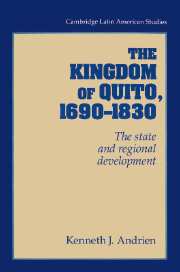Book contents
- Frontmatter
- Contents
- Acknowledgments
- Introduction
- PART I THE STATE AND SOCIOECONOMIC DEVELOPMENT
- 1 The late seventeenth-century crises
- 2 The people and markets of the kingdom
- 3 The state and manufacturing
- 4 Spanish agriculture and the rural economy
- 5 Amerindians and the market economy
- 6 Commerce and economic patterns
- PART II REFORM AND POLITICAL CONFLICT
- Appendixes
- Glossary
- Bibliography
- Index
4 - Spanish agriculture and the rural economy
from PART I - THE STATE AND SOCIOECONOMIC DEVELOPMENT
Published online by Cambridge University Press: 29 September 2009
- Frontmatter
- Contents
- Acknowledgments
- Introduction
- PART I THE STATE AND SOCIOECONOMIC DEVELOPMENT
- 1 The late seventeenth-century crises
- 2 The people and markets of the kingdom
- 3 The state and manufacturing
- 4 Spanish agriculture and the rural economy
- 5 Amerindians and the market economy
- 6 Commerce and economic patterns
- PART II REFORM AND POLITICAL CONFLICT
- Appendixes
- Glossary
- Bibliography
- Index
Summary
From the late sixteenth century, Spanish estates formed an essential link between colonial market centers and the rural zones of the north-central highlands. These agrarian enterprises had organized abundant land and labor resources in the interior to produce woolen textiles for export to Peru and New Granada. As a result, the diminishing demand for locally produced paños in the eighteenth century led to declining profits for rural estates in much of the region. The internal markets of the Andes also offered few alternatives to the traditional commerce in woolen cloth. High transport costs limited the ability of most bacendados to move from exporting textiles to selling their bulk crops in more distant regional markets. Over time, most successful rural estates were large enterprises, such as the holdings of the religious orders or the wealthiest members of the elite. Damaging Spanish commercial policies and rugged geographical barriers combined to force much of the rural economy in the north-central zone into greater isolation and stagnation.
In contrast, the agricultural economy of the south sierra experienced steady growth from the 1690s, as Andean migrants from depressed northern provinces provided a cheap labor force. The prosperity of most Spanish estates was linked to the demand for agricultural products and textiles in the local highland markets, Guayaquil, and northern Peru. Although the landholding elite played little role in cottage textile manufacturing, the cloth trade did stimulate the local agrarian economy, which helped pay for European imports. Some Spanish landowners also prospered by exploiting regional supplies of cascarilla.
- Type
- Chapter
- Information
- The Kingdom of Quito, 1690–1830The State and Regional Development, pp. 80 - 110Publisher: Cambridge University PressPrint publication year: 1995



